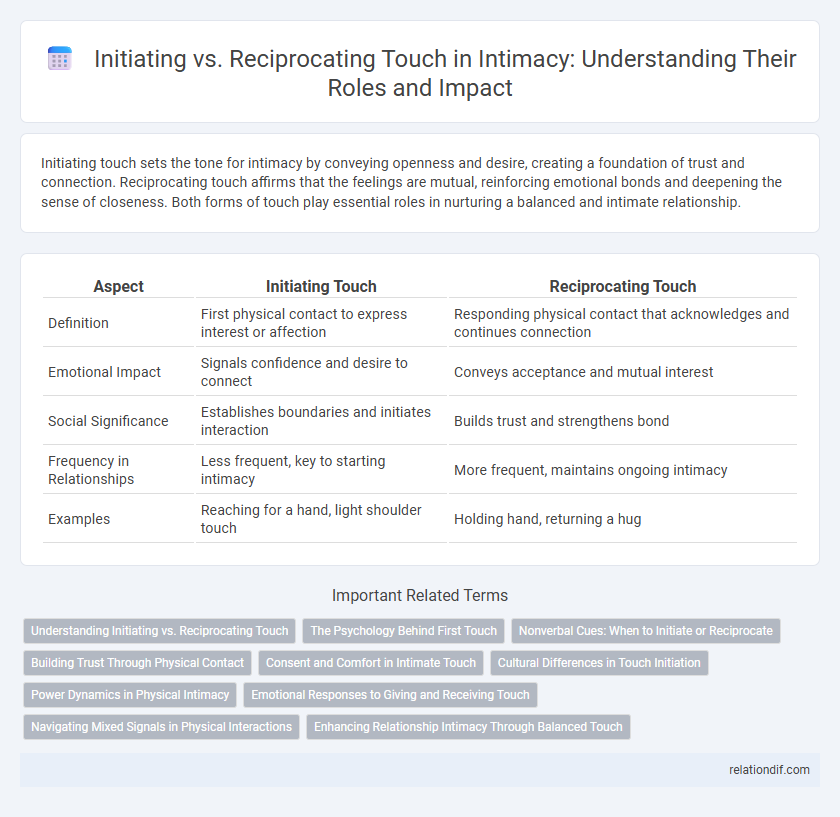Initiating touch sets the tone for intimacy by conveying openness and desire, creating a foundation of trust and connection. Reciprocating touch affirms that the feelings are mutual, reinforcing emotional bonds and deepening the sense of closeness. Both forms of touch play essential roles in nurturing a balanced and intimate relationship.
Table of Comparison
| Aspect | Initiating Touch | Reciprocating Touch |
|---|---|---|
| Definition | First physical contact to express interest or affection | Responding physical contact that acknowledges and continues connection |
| Emotional Impact | Signals confidence and desire to connect | Conveys acceptance and mutual interest |
| Social Significance | Establishes boundaries and initiates interaction | Builds trust and strengthens bond |
| Frequency in Relationships | Less frequent, key to starting intimacy | More frequent, maintains ongoing intimacy |
| Examples | Reaching for a hand, light shoulder touch | Holding hand, returning a hug |
Understanding Initiating vs. Reciprocating Touch
Initiating touch often signifies a proactive expression of affection or desire, reflecting confidence and emotional availability, while reciprocating touch demonstrates acceptance and mutual connection, reinforcing trust and intimacy. Understanding the subtle dynamics between initiating and reciprocating touch enables deeper emotional bonds and clearer communication in relationships. Research shows that successful intimate interactions rely on the balance between these touch behaviors to nurture closeness and psychological safety.
The Psychology Behind First Touch
Initiating touch triggers neural pathways associated with confidence and emotional leadership, activating oxytocin release that fosters trust and bonding. Psychological studies reveal that the first touch serves as a powerful nonverbal cue, influencing how intimacy is perceived and deepening emotional connection. Reciprocating touch, while important, often reinforces established comfort levels rather than creating the initial gateway to intimacy.
Nonverbal Cues: When to Initiate or Reciprocate
Nonverbal cues such as eye contact, body orientation, and facial expressions signal readiness for initiating or reciprocating touch in intimacy. Initiating touch often involves subtle gestures like a light hand on the arm or a gentle brush of the hair, indicating comfort and interest. Reciprocating touch responds to these signals, reinforcing connection and mutual consent through mirroring or returning the gesture.
Building Trust Through Physical Contact
Initiating touch in intimacy signals confidence and vulnerability, creating a foundation for emotional safety and trust between partners. Reciprocating touch validates these gestures, reinforcing mutual understanding and deepening the connection. Consistent, mindful physical contact fosters a secure environment where both individuals feel valued and respected.
Consent and Comfort in Intimate Touch
Initiating touch in intimate settings requires clear, enthusiastic consent to ensure mutual comfort and respect for personal boundaries. Reciprocating touch serves as a vital nonverbal cue that confirms comfort and willingness, reinforcing trust between partners. Prioritizing open communication about boundaries promotes a positive, respectful experience in all intimate interactions.
Cultural Differences in Touch Initiation
Cultural differences profoundly influence whether individuals initiate touch or prefer to reciprocate touch in intimate interactions, shaping social norms and personal comfort levels. In Mediterranean and Latin American cultures, initiating touch such as hugs or cheek kisses is a common expression of warmth and closeness, whereas many East Asian cultures prioritize reciprocating touch only after clear consent to maintain harmony and personal space. Understanding these cultural nuances is critical for fostering respectful intimacy and avoiding misinterpretations in cross-cultural relationships.
Power Dynamics in Physical Intimacy
Initiating touch often establishes a position of control within physical intimacy, signaling confidence or dominance, whereas reciprocating touch reflects responsiveness and mutual consent, balancing power dynamics between partners. The subtle interplay between who initiates and who responds can influence emotional safety and trust, shaping the intimacy experience. Understanding these nuances helps partners communicate boundaries and foster equitable connection.
Emotional Responses to Giving and Receiving Touch
Initiating touch often triggers feelings of vulnerability and empowerment, activating the brain's reward centers and fostering a sense of connection and trust. Reciprocating touch tends to evoke comfort and emotional validation, reinforcing bonding and releasing oxytocin for stress reduction and mood enhancement. Both giving and receiving touch engage neural pathways that contribute to emotional regulation, empathy, and deeper interpersonal intimacy.
Navigating Mixed Signals in Physical Interactions
Navigating mixed signals in physical interactions requires understanding the subtle differences between initiating touch and reciprocating touch within intimate contexts. Initiating touch often conveys clear intent and confidence, while reciprocating touch can reflect comfort, consent, or hesitation depending on accompanying body language and emotional cues. Recognizing these nuances helps prevent misunderstandings and fosters healthier, more respectful physical connections.
Enhancing Relationship Intimacy Through Balanced Touch
Initiating touch in relationships signals vulnerability and desire, fostering emotional closeness and trust between partners. Reciprocating touch reinforces connection, validating partners' affection and creating a positive feedback loop that deepens intimacy. Balanced touch, combining both initiation and reciprocal responses, promotes mutual understanding and strengthens the emotional bond essential for long-term relationship satisfaction.
initiating touch vs reciprocating touch Infographic

 relationdif.com
relationdif.com